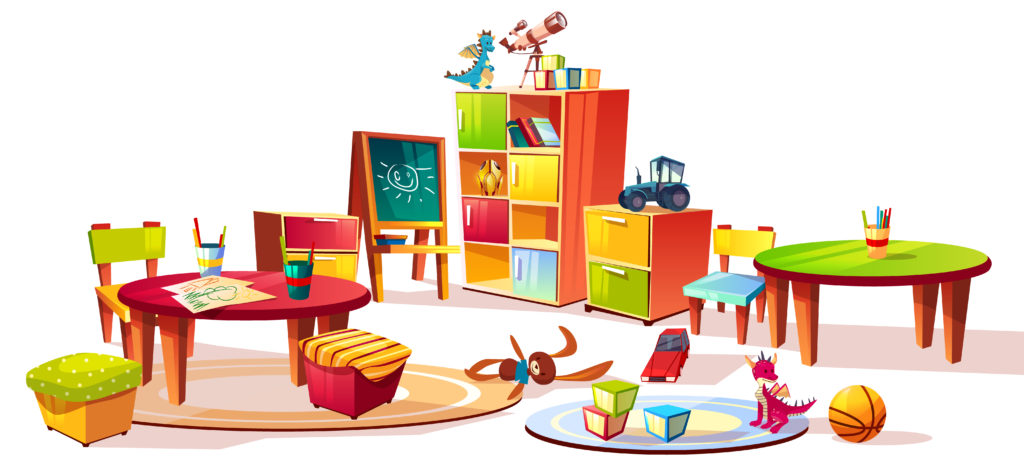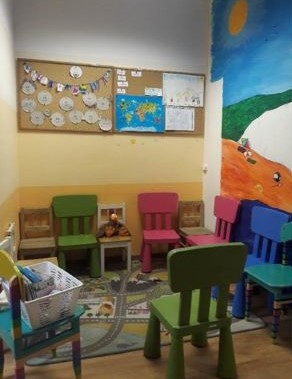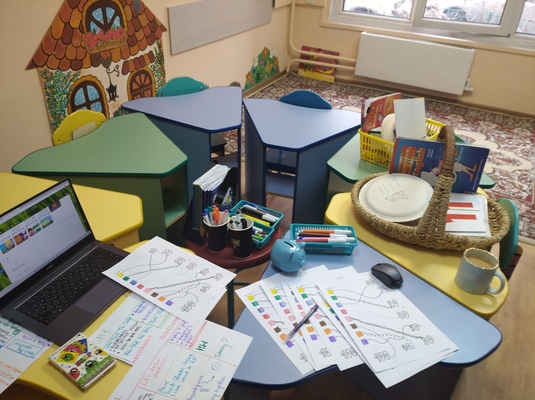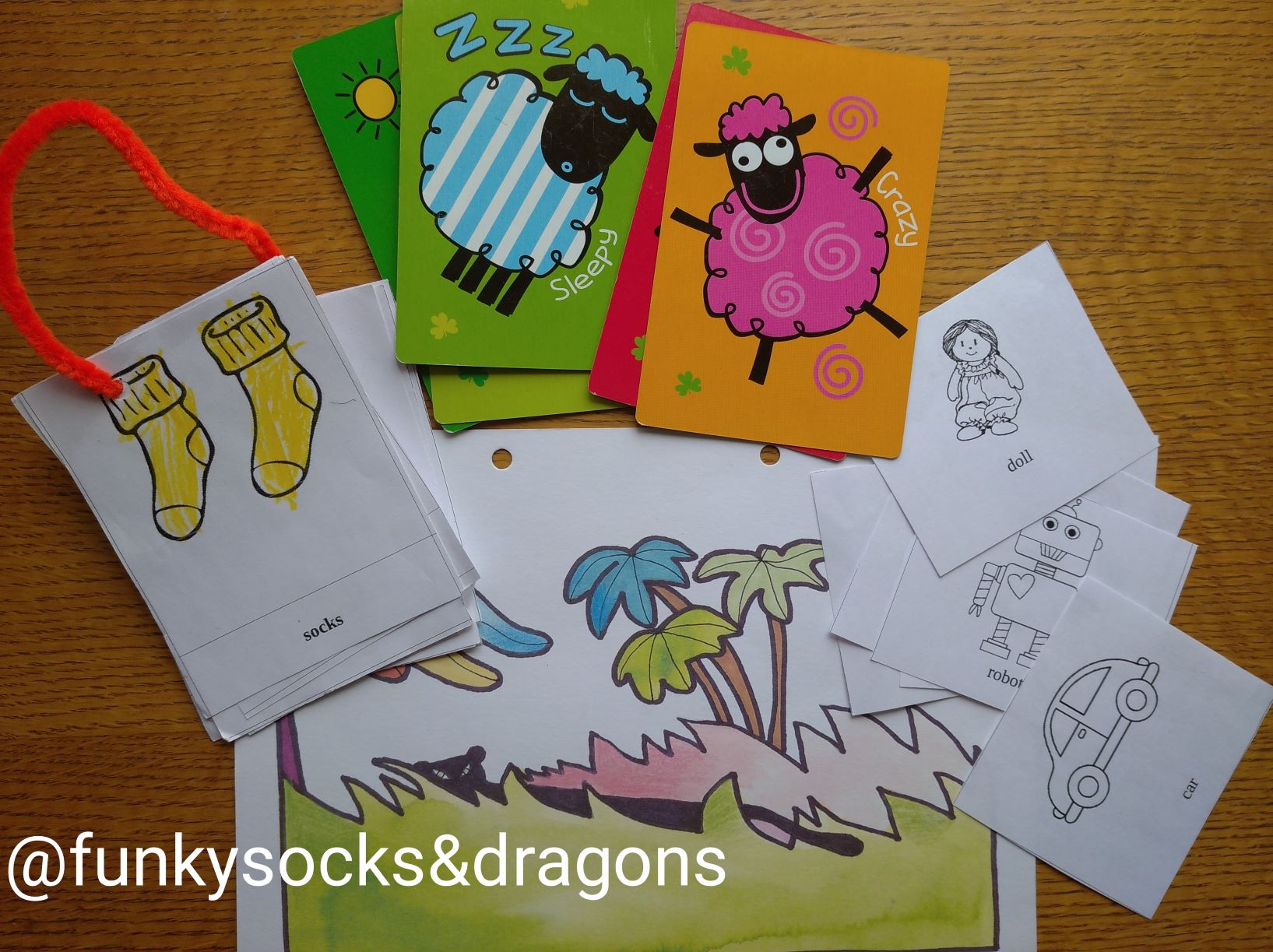
Case C: Off-site classes in kindergartens
The off-site EFL classes, with the teachers arriving to the kindergarten and teaching their lessons there are quite common.
Advantages
- The environment is by default child-friendly and safe
- There are carpets, small tables, small tables or chairs boards and posters are hung on the level of the children
- There are plenty of posters, toys, craft and stationery products that are child-friendly (ie crayons or safety scissors), books
- Children feel comfortable in the place, they know where to find the toilet, the spare shoe, their shelves
- Children already know their classmates
- There will be plenty of people who already know the children from the day activities and it will be a great advantage as the EFL teachers can use them as the source of information or even ideas.
Disadvantages
- Children are made to study English in a classroom that might be used for some other purposes, they might feel lost or confused when the room that they normally associate with playing will be the classroom in which they need to do some serious ‘studying’
- There might be too many distractors such as toys
- There might be some rules, routines and procedures in the institution that will also have to be taken into consideration, it is best to find out what these are and to try to combine them with the rules and procedures of the English lessons
- Children might struggle with transitioning between the regular kindergarten activities and the English lessons, provisions must be made for that, for example special routines
- Any kindergarten activities will have an impact on the flow of the English classes. There might be some specific holidays or trips that might influence the timetable or the curriculum but it is also quite likely that all the children might be tired or, on the contrary, excited on some days, due to the course of the day activities. They might also bring in their emotions and even animosities from the kindergarten.
Solutions
Where to look for ideas for the classroom
- Have a look at the classroom before the lesson and figure out how you can make it fit your aims and ideas, adapt when necessary and talk to the directors or supervisors to find out as much as possible about the institution and their procedures. If you are planning to introduce some changes, first and foremost focus on explaining the rationale for them. They might not be quite clear to people who are not language teachers but when you provide a rationale, they might be willing to take your suggestions into consideration. Involve your supervisor if you have one.
- Make the necessary decisions regarding the course such as the coursebooks, photocopying, homework and contacting the parents. These are not quite related to the classroom itself but a lot will be influenced here by the procedures and policies of the kindergarten and they might be different for one kindergarten to the other.
- Decide where you are going to start the lesson. Ideally, it should take place in a circle, on the carpet but there are other options, too: at the door, in a circle standing. Even if it is a classroom with small desks, there will be some space in-between the board and the first rows or at the back, behind the last row.
- Decide where in the classroom you are going to have the storytelling corner, the movement corner and where you are going to sit to work with the coursebooks or handouts.
- Build up your routine and stick to it.
- Remove the distractors if possible or as many of them as possible.
- Find out which of the kindergarten resources you are allowed to use.
- Decide where you are going to keep your things and resources such as crayons or markers for the lesson, handouts, flashcards for the lesson. Please use the same place and make sure you establish with the children that they are not allowed to touch anything that is on the table. It might help to keep everything in a box (as it can be easily lifted to keep it away from the children), it is easy to store and it makes cleaning easy. What is more, if you keep all your resources in one container, you gain a lot of flexibility as all your toys are there, in case you need to change your lesson plan. I have had groups with whom I had to keep all my resources in my rucksack, zipped shut in the begining of the course.
- Talk to the kindergarten’s stuff and ask them to find a place for you to store your resources in-between the lesson. Otherwise you will have to carry all your resources with you all the time.
- It is a good idea to talk to the kindergarten’s admin to find out whether and where you can put the students’ work on display. There might be some room in the classroom or in the hallway and it is quite likely that the administration will like the idea of assigning a noticeboard for you and the English classes work. They will also benefit from promoting the classes to the parents whom the teacher most likely is not going to meet in person.
Where to find more ideas?
Sandie Mourao and Gail Ellis ,Teaching English to Pre-primary Children, Delta Publishing
Vanessa Reilly and Sheila Ward, Very young learners, OUP
Herbert Puchta and a big group, there is a semi-circle of small chairs but the room is big enough for the kids to be able to stand up and play some movement games without actually moving too much around the room
A realistic preschool classroom, not quite EFL pre-school but real life.
And another one from PreKPages a great channel on youtube where you can find lots and lots of ideas for working with preschoolers.
A lesson and a classroom from WOW English
And a lesson from Japan from a big sports hall.
And another classroom from China.
Here are also the links to the other two posts in this mini-series, both devoted to teaching in language schools, in a classroom that is used only by the VYL students and the classroom that the little people have to share with other classes.


